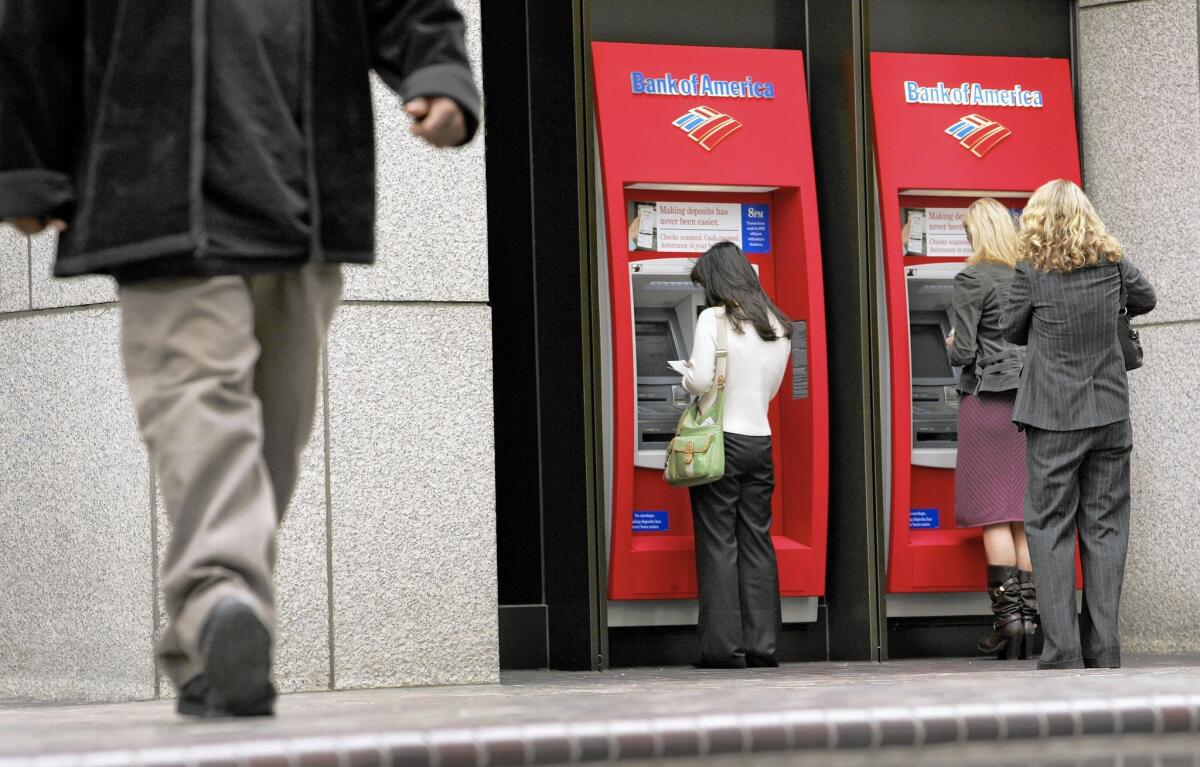How to avoid the fees that bring billions in revenue to big banks

To hear big banks tell it, this is a great time to be a bank customer.
Most Americans — 61% — pay no monthly fees for things like checking accounts and use of automated teller machines, according to a recent survey by the American Bankers Assn.
“We’ve seen tremendous innovations to bank services over the last decade that have allowed our customers to bank in the way that is most convenient for them and at little or no cost,” said Nessa Feddis, the organization’s senior vice president and deputy chief counsel for consumer protection and payments.
Good times.
Oh wait, what’s this? It’s a recent report from SNL Financial showing that in the first quarter, three of the largest U.S. banks collectively generated more than $1 billion from service charges and overdraft fees.
JPMorgan Chase & Co., Bank of America Corp. and Wells Fargo & Co. each reported pocketing more than $350 million in overdraft fees over the three-month period.
Wells also reported $90 million in ATM fees, BofA $87 million and Chase $56 million, according to the report.
These eye-opening numbers come courtesy of the federal government, which now requires that banks with more than $1 billion in assets disclose such charges instead of lumping them with other income, as they used to do.
In all, banks falling under the new disclosure requirement took in more than $2.5 billion from bounced checks in the first quarter and about $438 million in ATM fees. Monthly account-maintenance fees produced an additional $974 million in revenue.
So what happened to that idea that most of us aren’t paying any fees?
“Don’t let it confuse you,” said Ruth Susswein, deputy director of national priorities for the advocacy group Consumer Action. “If you’re someone with big bank deposits, you’re probably one of that 61% paying nothing in fees.”
However, if you’re a working stiff living paycheck to paycheck, unable to maintain a minimum balance of hundreds of dollars, you’re likely among those generating billions of dollars in fees for banks.
“It’s the people who can least afford it,” Susswein said. “The ones with lower or middle incomes who aren’t part of the fortunate 61%.”
The overdraft fees for the first quarter alone are particularly troubling. At that rate, Chase, BofA and Wells would see $4.5 billion in such fees for the full year. The typical charge for a bounced check runs $35.
Banks had been pushing overdraft insurance on account holders until, in a move to protect consumers, federal regulators required banks to seek customers’ consent before signing them up for overdraft coverage. But that rule just applies to one-time-only debit-card transactions.
If you use your checking account for recurring payments, such as rent, of if you use an old-fashioned paper check, a bank can still pop you with an overdraft fee if you go into the red — regardless of whether you opted out of protection.
Some banks seem to try to put customers into arrears by processing transactions not in chronological order but from largest to smallest, thus raising the likelihood of triggering multiple overdrafts once an account is depleted.
Avoiding bank fees can be tricky. A recent study by the financial website WalletHub found that not all fees are disclosed upfront in an easily accessible manner, making it difficult for consumers to compare institutions.
That said, there are steps everyone can take to improve their chances of being among the 61% that the banking industry says inhabit No Fee Land.
If you haven’t already, opt out of overdraft protection and do your best to maintain some spare cash in your checking account to cover any payment you forgot to mark down.
Ask about alerts. If requested, most big banks will send you a text or email if your account drops below a certain level.
Look around for the best deal on checking and savings accounts. You can avoid a $10 or $12 monthly maintenance fee by arranging for some form of regular income — your paycheck, say, or Social Security benefit — to be deposited automatically in your account.
Or you can maintain a minimum balance each month. Some big banks set the bar high at $1,500, but others require only a fraction of that amount.
Take a look at online-only banks such as Ally Bank or Bank of Internet USA. Many offer fee-free checking accounts. And don’t forget credit unions, which tend to have more consumer-friendly policies as a matter of principle.
However, make sure you pick a bank or credit union with enough ATMs to keep you in-network no matter where you go. Using out-of-network ATMs is a sure-fire recipe for racking up unwanted fees.
Finally, don’t be shy about asking your bank to waive an unexpected fee. That’s not something you can do frequently, but most banks will cut some slack for customers in relatively good standing.
The American Bankers Assn. says “consumers hold all the cards” when it comes to financial services these days. That’s laughably untrue.
But we’re not bluffing either.
David Lazarus’ column runs Tuesdays and Fridays. He also can be seen daily on KTLA-TV Channel 5 and followed on Twitter @Davidlaz. Send your tips or feedback to [email protected].
More to Read
Inside the business of entertainment
The Wide Shot brings you news, analysis and insights on everything from streaming wars to production — and what it all means for the future.
You may occasionally receive promotional content from the Los Angeles Times.











